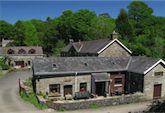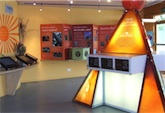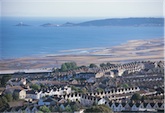Swansea Wales. The city by the sea. There are few cities in Britain, if any, that enjoy such a spectacular natural location as Swansea enjoys – it is sandwiched between an expansive sandy beach and heather clad mountains. It is just a 20 minute drive down the valley from our self catering holiday cottage. Wales’ second city is home to Dylan Thomas, the world’s first passenger railway, and randomly, the 2nd largest tidal range in the world (it’s 9 metres in springtime!)
Follow Swansea Bay round from the city centre all the way round past Singleton Park, where the National Pool of Wales now lives, currently the only Olympic sized pool in the country. Turn right for the beautiful golden sand beaches of the Gower, the first designated Area of Outstanding Natural Beauty in Britain, or straight ahead for a crawl along the famous pub-lined Mumbles Mile. Around the corner you can walk along the gap-toothed old pier, or clamber around the rocky edge of Swansea Bay’s beach.
If you are a sports fan, the road joining Mumbles Head to the city of Swansea passes the old Vetch ground, historic home of Swansea City Football Club, alongside the jail, where lucky prisoners could watch the match if they had a pitch-side cell. Further down the road is St Helen’s Cricket Ground, a home ground of Glamorganshire county cricket and the pitch where Garfield Sobers once famously hit six sixes in a single over.
On entry to the city centre you will see the sprawling greenhouse of Plantasia, a mini tropical paradise, complete with giant African snails and poisonous frogs. Discover over 800 different plant species live here, with monkeys and reptiles.
As Wales’ oldest museum, Swansea Museum has its own Mummy and Egyptian artefacts, and within strolling distance to Wales’ newest museum, the National Waterfront Museum. Alongside the museum is the SA1 tower – Wales’ tallest building. The top floor has a restaurant with spectacular views down the coast and across the city.
Fans of the celebrated alcoholic poet Dylan Thomas can follow his trail, which includes a visit to his birthplace. The Dylan Thomas Centre, which has a permanent exhibition, ”˜In My Own Intricate Image’ as well as a souvenir shop and obviously, a bar.
In the centre of town is a monument to Thomas’ poetry – a leaf sculpture in a fountain. Walk around the fountain and read the poem, then look back at the setting – the 14th Century ruins of the castle in ruins alongside the more glamorous blue high-rise BT building.
Swansea, once copper capital of world, was bombed extensively in the war, with little surviving intact. To find out more, visit a new Swansea attraction – the 1940s war museum, located on the way into the city from the east. Wind Street, is one of the few streets left intact after the bombing and is now permanently celebrating – the street is lined with pubs and restaurants. Suitably pronounced ”˜Wine’ rather than Wind Street, the street hides a little alleyway worth a visit – Salubrious Passage with its second hand bookshop.
Visit Swansea indoor market for local produce, taste some faggots and peas or even some cockles and lava bread if you are feeling daring – that’s soggy seaweed to the uninitiated, a local speciality.
In Brangwyn Hall hang some lesser-known paintings of the great Empire, by Frank Brangwyn. The enormous canvases illuminate the walls of otherwise drab main hall with colour from four corners of the globe packed into 18 panels of light and life. More art can be found at the Glynn Vivian Art Gallery which has traditional and modern Welsh art, with pieces by Augustus John and Ceri Richards. There is also a sculpture court and an international collection of porcelain and Swansea china.
With anything and everything from history to jet skiing, the seaside city of Swansea awaits your visit.
Swansea Valley Holiday Cottages
Getting to Swansea City from Swansea Valley Holiday Cottages
(i) By car. Our self catering holiday cottages are an easy 20 minute drive from Swansea City Centre. Head two miles downhill to Pontardawe and then follow signs to the city. There are a number of well signposted multi storey car parks in Swansea City Centre.
The population of Swansea is 223,301 making it Wales’s second largest city. In Welsh it is known as Abertawe which means “the mouth of the quiet river”. (The quiet river is the River Tawe which gets is name from the Welsh word for quiet which is tawel). The Vikings named the area Sveins Ey (Swein’s Island), probably referring to the sandbank in the mouth of the river. Over the years this became Swansea. It’s Welsh name is Abertawe which means ‘mouth of the river Tawe’.
In June 1910, Captain Robert Falcon Scott set sail from Cardiff on his tragic expedition to the Antarctic, berthing in the docks for six days as an acknowledgement of the considerable financial support raised locally. Welshman Petty Officer Edgar Evans, born in Gower and brought up in Swansea was an integral part of the expedition.
Our self catering Welsh holiday cottages are a perfect base from which to take in the tourist attractions of Swansea, Wales’s second city.




